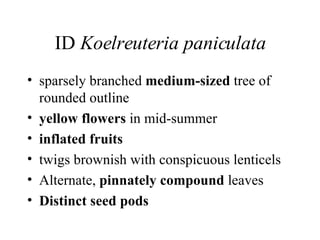Woody Plants Group 2b
- 1. Group 2 B Cercis canadensis Gleditsia triacanthos var. inermis Gymnocladus dioca (dioicus) Koelreuteria paniculata Robina pseudoacacia Sophora japonica Eastern Redbud Thornless Honeylocust Kentucky Coffeetree Goldenrain Tree Black Locust Japanese Pagoda Tree
- 3. Cercis canadensis Eastern Redbud
- 7. ID Cercis canadensis a small, deciduous tree 20' to 30' tall 25' to 35' wide zigzag stem growth heart-shaped leaves numerous rosy-pink pea-like flowers short main trunk scaly dark brown bark with orange inner bark broad rounded to flat-topped shape when mature persistent legume pod fruits flower buds stalked and in clusters
- 8. Cercis canadensis liabilities twig kill and dieback in zones 5 and 4 wood can be brittle with trees splitting at crotches persistent fruits can be objectionable canker tends to be short-lived, especially when exposed to chronic stresses
- 9. Gleditsia triacanthos var. inermis Thornless Honeylocust
- 10. ID Gleditsia triacanthos pinnate and bipinnately compound leaves upright-spreading, arching or horizontal branching large thorns on trunk and branches large flat, twisted pods
- 11. Gleditsia triacanthos a medium to large deciduous tree 50' to 60' tall spread is usually equal to height branching is upright-spreading to arching or more or less horizontal some trees become nearly flat-topped rather loose and open casts only light shade develops a short main trunk
- 15. Gleditsia triacanthos liabilities large thorns can be dangerous pods can be messy bagworm spider mites mimosa webworm pod gall midge cankers
- 16. Gymnocladus dioicus Kentucky Coffeetree
- 17. Gymnocladus dioicus a large deciduous tree grows up to 75' tall or even larger develops a 40' to 50' spread upright to irregular branching coarse, but picturesque branching in winter
- 19. Gymnocladus doicus ID buds embedded in wood, barely visible through a small "belly button"-like opening bud considerably above the leaf scar female plants with large, chunky pods large heart - shaped leaf scars
- 21. Koelreuteria paniculata Golden Raintree
- 25. ID Koelreuteria paniculata sparsely branched medium-sized tree of rounded outline yellow flowers in mid-summer inflated fruits twigs brownish with conspicuous lenticels Alternate, pinnately compound leaves Distinct seed pods
- 26. Robinia pseudoacacia Black Locust ID pinnately compound blue-green leaves narrow crown widest near the top white pendulous clusters of pea-like flowers; fragrant rope-like, thick, gray bark persistent flat brown pods stems glabrous with thorns around the buds on vigorous shoot
- 34. Robinia pseudoacacia liabilities Messy spread by seed and root suckers locust borer leaf miner can totally disfigure plants by summer making them appear as through hit by a flame thrower
- 35. ‘Purple Robe’
- 36. Purple Robe high to moderate water
- 37. Sophora japonica Japanese Pagoda Tree
- 38. Sophora japonica Big 40-60’ tree Alternate, pinnately compound dark green leaves No Fall color White, pea-like flower in Summer 3-8” string like pod
- 43. Sophora japonica ID olive-green bark on stems and young branches with raised tan lenticels fleshy, greenish pod as a fruit with constrictions between seeds upright wide spreading habit pea-like flowers terminal fruit persists
- 44. Liabilities twig kill in severe winters canker that is made worse by cold injury can be messy due to dropped petals, fruit, and leaves
- 45. Pendula – no flowers
- 46. ‘Regent’ This superior form is probably the most common selection in commerce It grows more quickly to form a broad-rounded crown to 50' tall It reportedly begins to flower earlier than seedlings, plus the foliage is glossy and handsome. It has performed well in urban, polluted areas.
- 48. ID by Leaf
- 53. ID by Flower
- 57. ID by Fruit
- 59. Small Pod
- 60. Long Pod
- 61. Chunky pod
- 63. ID by entire tree
































































